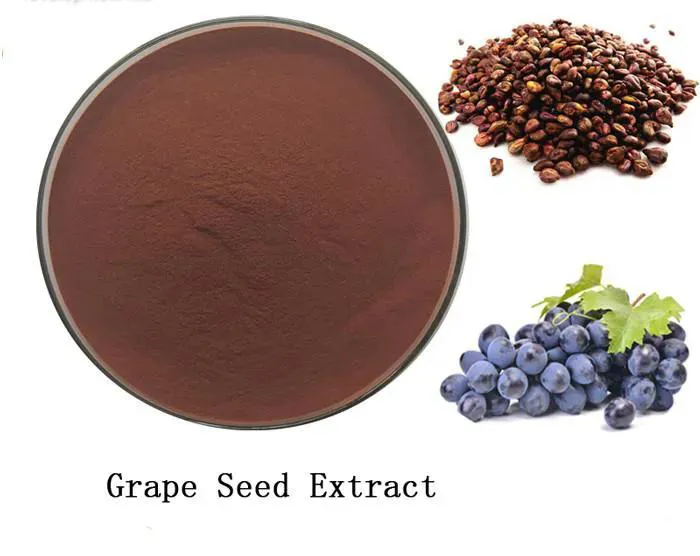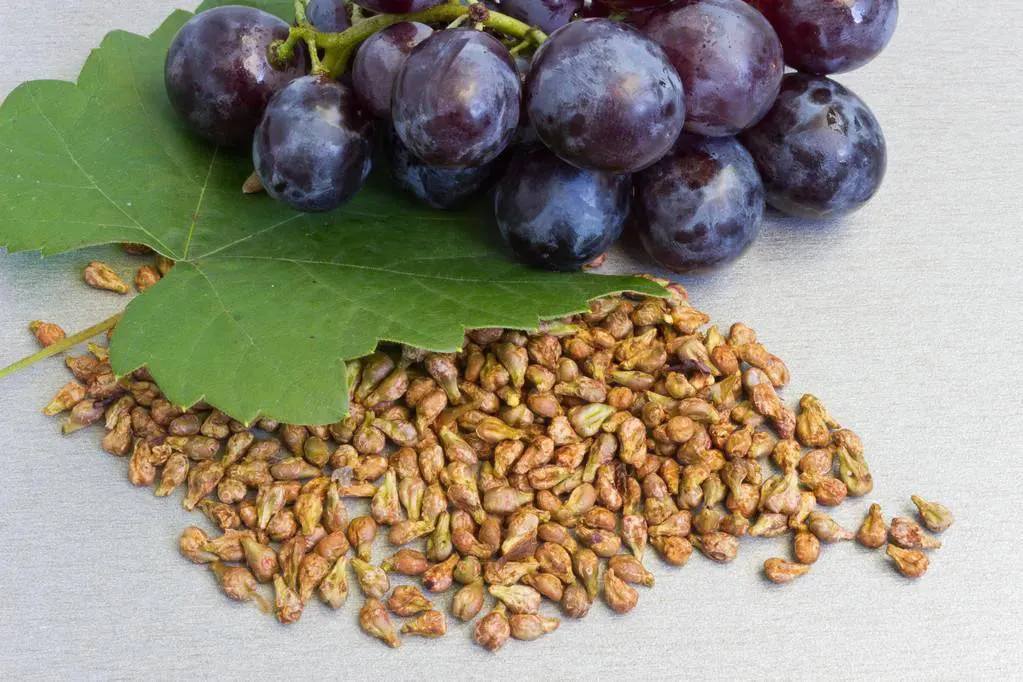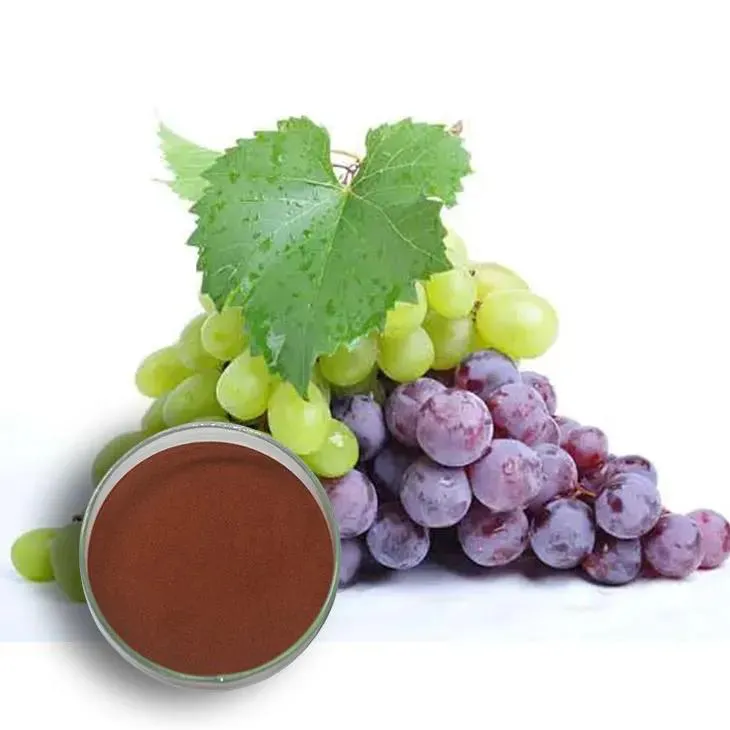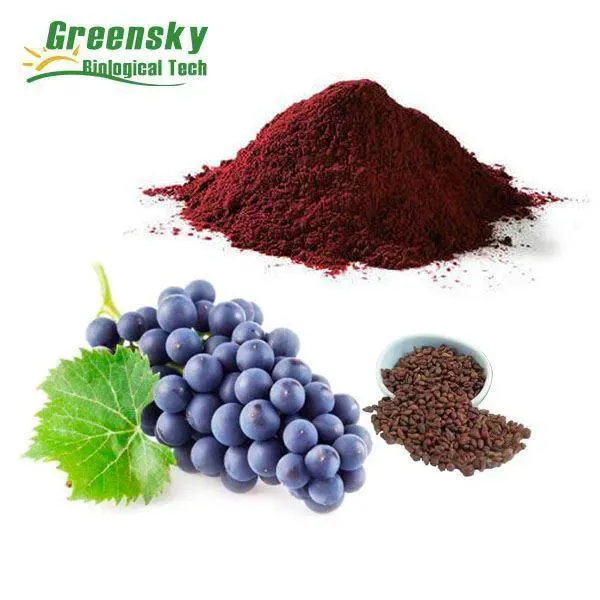- 0086-571-85302990
- sales@greenskybio.com
Seeds of Health: A Detailed Look at the Extraction and Purification of Grape Seed Extract
2024-08-15

1. Introduction
Grape seeds, often overlooked in the process of winemaking and grape consumption, are a rich source of bioactive compounds. These compounds are associated with numerous health - promoting properties. The extraction and purification of Grape Seed Extract (GSE) have become an area of significant interest in recent years, both in the scientific community and in various industries such as medicine, cosmetics, and dietary supplements.

2. Health - Promoting Properties of Grape Seeds
Grape seeds are known to contain a variety of beneficial substances. One of the most important is proanthocyanidins, a type of flavonoid. Proanthocyanidins are powerful antioxidants that can help neutralize free radicals in the body. Free radicals are unstable molecules that can cause damage to cells, DNA, and proteins, and are associated with various diseases such as cancer, heart disease, and neurodegenerative disorders.
Another important component of grape seeds is resveratrol. Resveratrol has been shown to have anti - inflammatory, anti - aging, and cardioprotective effects. It may also play a role in protecting against certain types of cancer. In addition to these, grape seeds contain other flavonoids, phenolic acids, and fatty acids, all of which contribute to their overall health - promoting potential.

3. Extraction of Grape Seed Extract
3.1 Mechanical Extraction
Mechanical extraction methods are often the first step in obtaining Grape Seed Extract. This typically involves crushing the grape seeds to release the bioactive compounds. One common method is to use a press. The seeds are placed in a press, and pressure is applied to squeeze out the oils and other substances containing the beneficial compounds.
Another mechanical method is grinding. Grinding the seeds into a fine powder can increase the surface area, allowing for better extraction in subsequent steps. However, mechanical extraction methods alone may not be sufficient to extract all of the desired compounds, and they may also produce a relatively crude extract that contains a significant amount of impurities.
3.2 Chemical Extraction
Chemical extraction methods are often used in combination with mechanical extraction to improve the yield and quality of the grape seed extract. One common chemical solvent used is ethanol. Ethanol is a relatively safe and effective solvent for extracting the bioactive compounds from grape seeds.
The process of chemical extraction using ethanol typically involves soaking the crushed or ground grape seeds in an ethanol solution for a certain period of time. This allows the ethanol to dissolve the bioactive compounds, which can then be separated from the seeds. Other solvents that may be used include methanol and acetone, although these are less commonly used due to their potential toxicity.
However, chemical extraction also has its challenges. The choice of solvent, the concentration of the solvent, and the extraction time all need to be carefully optimized to ensure maximum extraction of the desired compounds while minimizing the extraction of unwanted substances. Additionally, the use of solvents requires proper handling and disposal to ensure environmental and safety compliance.

4. Purification of Grape Seed Extract
Purification is a crucial step in the production of high - quality grape seed extract. The purpose of purification is to remove impurities such as unextracted plant material, solvent residues, and other unwanted compounds. There are several methods commonly used for purification.
4.1 Filtration
Filtration is a simple and commonly used method for removing large particles and some impurities from the grape seed extract. There are different types of filtration methods, such as gravity filtration and vacuum filtration. Gravity filtration involves passing the extract through a filter medium under the force of gravity. Vacuum filtration, on the other hand, uses a vacuum to speed up the filtration process.
Filtration can remove solid impurities such as pieces of unextracted seeds or plant debris. However, it may not be sufficient to remove all types of impurities, especially smaller molecules and solvent residues.
4.2 Centrifugation
Centrifugation is another method used for purification. In centrifugation, the grape seed extract is spun at high speeds in a centrifuge. This causes the heavier particles and impurities to sediment at the bottom of the centrifuge tube, while the purified extract remains on top. Centrifugation can be effective in removing some types of impurities, such as suspended solids and some large molecules.
However, like filtration, centrifugation may not be able to remove all impurities, especially those that are soluble in the extract or are very small in size.
4.3 Chromatography
Chromatography is a more advanced and highly effective method for purifying grape seed extract. There are different types of chromatography, such as column chromatography, high - performance liquid chromatography (HPLC), and gas chromatography. In column chromatography, the extract is passed through a column filled with a stationary phase, and different components of the extract are separated based on their affinity for the stationary phase.
HPLC is a more sophisticated form of chromatography that can provide very high resolution separation of the components of the grape seed extract. It is often used to purify and analyze the individual components of the extract, such as proanthocyanidins and resveratrol. Gas chromatography is mainly used for analyzing volatile components of the extract.

5. Significance of High - Quality Grape Seed Extract in Different Fields
5.1 Medicine
In the field of medicine, high - quality grape seed extract has shown great potential. Its antioxidant and anti - inflammatory properties make it a candidate for the treatment and prevention of various diseases. For example, it may be used in the prevention of cardiovascular diseases by reducing oxidative stress and inflammation in the blood vessels. It may also have potential applications in the treatment of diabetes, as it can help improve insulin sensitivity.
Furthermore, some studies have suggested that grape seed extract may have anti - cancer properties. It may be able to inhibit the growth and spread of cancer cells by interfering with various cellular processes involved in cancer development. However, more research is needed to fully understand its potential in cancer treatment.
5.2 Cosmetics
In the cosmetics industry, grape seed extract is highly valued for its antioxidant and anti - aging properties. It can be used in various cosmetic products such as creams, serums, and lotions to protect the skin from free radical damage and to improve skin elasticity. The proanthocyanidins in grape seed extract can also help to strengthen the skin's collagen network, which is important for maintaining youthful - looking skin.
Grape seed extract is also used in hair care products. It can help to nourish the hair follicles, improve hair strength, and reduce hair loss. Its antioxidant properties can protect the hair from environmental damage such as UV radiation and pollution.
5.3 Dietary Supplements
As a dietary supplement, grape seed extract is becoming increasingly popular. It is often taken in the form of capsules or tablets. People take grape seed extract supplements for various reasons, such as to boost their immune system, improve their overall health, and prevent chronic diseases. The antioxidant content of grape seed extract can help to scavenge free radicals in the body, reducing the risk of oxidative damage.
However, it is important to note that the quality and purity of grape seed extract supplements can vary widely. Consumers should choose products from reputable manufacturers to ensure that they are getting a high - quality and safe supplement.
6. Conclusion
The extraction and purification of grape seed extract are complex processes that require careful attention to detail. The potential health - promoting properties of grape seeds make the production of high - quality grape seed extract an important area of research and development. Whether in medicine, cosmetics, or dietary supplements, high - quality grape seed extract has significant potential for improving human health and well - being. Continued research in this area will likely lead to further understanding of the benefits of grape seed extract and the development of more effective extraction and purification methods.
FAQ:
What are the potential health - promoting properties of grape seeds?
Grape seeds are rich in various bioactive compounds such as proanthocyanidins, flavonoids, and phenolic acids. These compounds are associated with antioxidant, anti - inflammatory, and cardiovascular - protective effects. They can help scavenge free radicals in the body, reduce oxidative stress, and potentially prevent or manage certain chronic diseases.
What are the mechanical methods for grape seed extract extraction?
Mechanical methods for grape seed extract extraction often involve processes like grinding and pressing. Grinding the grape seeds breaks them into smaller particles, increasing the surface area available for extraction. Pressing then helps to squeeze out the extract. These methods are relatively simple and can be a first step in obtaining the initial extract, but they may not be as efficient as some chemical methods in extracting all the desired components.
How do chemical methods contribute to the extraction of grape seed extract?
Chemical methods can use solvents such as ethanol or methanol. These solvents are able to dissolve the bioactive compounds present in the grape seeds more effectively compared to mechanical methods alone. The use of chemical solvents helps in breaking down the cell walls of the grape seeds and extracting a wider range of compounds. However, proper handling and purification are required to ensure the removal of the solvent residues.
Why is purification crucial in the production of grape seed extract?
Purification is crucial because the initial extract obtained through extraction methods may contain impurities such as plant debris, proteins, and other unwanted substances. These impurities can affect the quality, safety, and efficacy of the grape seed extract. Purification steps help to remove these contaminants, resulting in a high - quality extract that is suitable for use in medicine, cosmetics, and dietary supplements.
How is high - quality grape seed extract used in the field of medicine?
In the field of medicine, high - quality grape seed extract has been studied for its potential role in preventing and treating various conditions. It may be used in the management of cardiovascular diseases, for example, due to its antioxidant and anti - inflammatory properties. Some research also suggests its potential in cancer prevention and treatment, although more studies are needed. Additionally, it may have applications in wound healing and reducing the risk of diabetic complications.
Related literature
- Grape Seed Extract: A Review of its Antioxidant, Anti - Inflammatory, and Potential Health Benefits"
- "Extraction and Characterization of Bioactive Compounds from Grape Seeds for Cosmetic Applications"
- "The Role of Grape Seed Extract in Dietary Supplements: Quality Control and Efficacy"
- ▶ Hesperidin
- ▶ citrus bioflavonoids
- ▶ plant extract
- ▶ lycopene
- ▶ Diosmin
- ▶ Grape seed extract
- ▶ Sea buckthorn Juice Powder
- ▶ Beetroot powder
- ▶ Hops Extract
- ▶ Artichoke Extract
- ▶ Reishi mushroom extract
- ▶ Astaxanthin
- ▶ Green Tea Extract
- ▶ Curcumin Extract
- ▶ Horse Chestnut Extract
- ▶ Other Problems
- ▶ Boswellia Serrata Extract
- ▶ Resveratrol Extract
- ▶ Marigold Extract
- ▶ Grape Leaf Extract
- ▶ blog3
-
Buckthorn bark extract
2024-08-15
-
Yam Extract
2024-08-15
-
Green coffee bean Extract
2024-08-15
-
Sophora Flavescens Root Extract
2024-08-15
-
Tormentil Extract
2024-08-15
-
Troxerutin
2024-08-15
-
Black Rice Extract
2024-08-15
-
Red Wine Extract
2024-08-15
-
Tamarind extract powder
2024-08-15
-
Passionflower Extract
2024-08-15





















